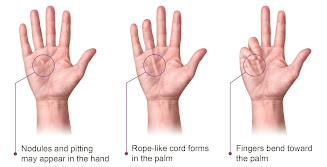Dupuytren’s
Contracture is a disorder of the hand that develops when the fibrous tissue
layer begins to thicken. This results in
lumps forming which cause tightening of the palm and difficulty bending the
little and middle fingers. It is not
usually painful but in some cases, discomfort is reported.
Who is at risk of
Dupuytren’s Contracture?
The
condition is most common in men and the onset increases with age. Other cases may include:
- People
over 40 years of age.
- People
of a northern European or Scandinavian background.
- People
with a family history of the condition.
- People
who smoke or drink alcohol.
- People
who have diabetes.
What are the
treatments for Dupuytren’s Contracture?
Dupuytren’s Contracture treatment depends on whether the person’s finger position is limiting their ability to perform daily activities. When the position of the fingers is severe, the most effective treatment options to correct deformity include home and surgical treatments, which include:
- Dupuytren’s
wand and tape.
- Needle
aponeurotomy.
- Enzyme
injections.
- Surgery.
All of the above treatments come with varying risks, benefits and levels of effectiveness.
Will the deformity
return?
There is no permanent cure for Dupuytren’s Contracture at present. All treatments risk recurrence after some time. The rate of recurrence is higher with the needle procedure than surgery or enzyme injections. The Dupuytren’s Contracture wand and tape help provide relief from pain and discomfort. Regular use of the tape and wand offers comfort and the ability to move your hand correctly. See your doctor for the best Dupuytren’s Contracture therapy.

Comments
Post a Comment